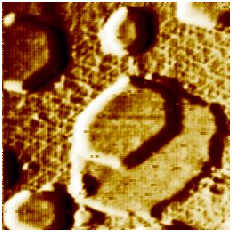ATOMIC SCALE CHARACTERIZATION OF ULTRATHIN OXIDE FILMS AND METAL/OXIDE INTERFACES
WG2 members: András Berkó, László Óvári, László Deák, Arnold Farkas, Imre Szenti, Richárd Gubó, Gábor Vári, János Kiss, Frigyes Solymosi, András Erdőhelyi, Albert Oszkó, Zoltán Kónya
homepage: www2.sci.u-szeged.hu/radio_rekin/index.html

STM image of 20 x 20 nm2 recorded on Rh(111) top facet of a Rh nanocrystallite supported on TiO2(110) surface and encapsulated by TiOx ultrathin oxide layer (hexagonal “wagon wheel” structure – Z. Majzik, N. Balázs, A. Berkó, J. Phys. Chem. C 115 (2011) 9535). Deposition of Au resulted in mono and bilayer Au nanocrystallites resistant of encapsulation.
We continue of our 10-15 years efforts to develop two-dimensional (2D) catalytic model systems with tailored structural and chemical properties. This philosophy led us to control the size and lateral distribution of noble metal nanoparticles grown on oxide single crystal surfaces [1]. This idea was recently extended to develop a method to form supported bimetallic Rh-Au core-shell nanoparticles on TiO2(110) surface [2]. In this way we succeeded to control not only the particle size and lateral distribution, but also the chemical composition of the nanoparticles close to atomic level. The application of the scanning tunneling microscopy and spectroscopy for studying these systems is a big challenge. Our primary aim is to fabricate these model catalytic systems, which will be followed by the examination of different catalytic and photocatalytic reactions, like hydrogen production, CO oxidation, CO2 activation, etc. In these latter works, the special topics will also be studied with other spectroscopy techniques like XPS, HREELS, RAIRS, LEIS, WF-measurement and TDS.
[1] A. Berkó, G. Klivényi and F. Solymosi: J. Catal. 182 (1999) 511.
[2] L. Óvári, A. Berkó, N. Balázs, Z. Majzik, J. Kiss: Langmuir 26(3) (2010) 2167.


